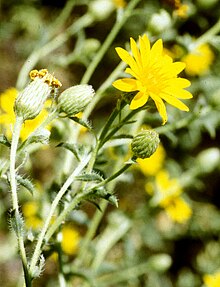Heterotheca
| Heterotheca | |
|---|---|
 |
|
| Heterotheca shevockii | |
| Scientific classification | |
| Kingdom: | Plantae |
| (unranked): | Angiosperms |
| (unranked): | Eudicots |
| (unranked): | Asterids |
| Order: | Asterales |
| Family: | Asteraceae |
| Tribe: | Astereae |
| Genus: |
Heterotheca Cass. |
| Type species | |
|
Heterotheca lamarckii syn of H. subaxillaris Cass. |
|
| Synonyms | |
|
|
Heterotheca, (common names golden asters, false goldenasters, camphorweed, or telegraph weed) are North American plants in the sunflower family.
Heterotheca comes from Ancient Greek ἕτερος héteros "other, different" and θήκη thḗkē "case, chest", and refers to the fact that, in some species in the genus, the cypselae (achenes containing seed) of the disk and ray florets have different shapes.
These are annual and perennial herbs bearing daisy-like flower heads with yellow disc florets and usually yellow ray florets, associated with mesic to xeric habitats across North America. Several species now included in Heterotheca were previously classified in the genus Chrysopsis
Heterotheca species are often used as food plants by the larvae of some Lepidoptera species including Schinia lynx, Schinia nubila and Schinia saturata (all of which have been recorded on Heterotheca subaxillaris).
The leaf volatiles from which the name "camphorweed" is derived include camphor, but as a minor constituent (less than 2%); of the 41 documented volatiles in a study of Heterotheca subaxillaris, for example, caryophyllene, pinene, borneol, myrcene, and limonene each comprised over 5% of the total.
...
Wikipedia
